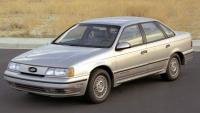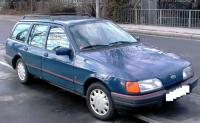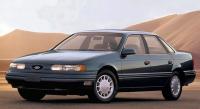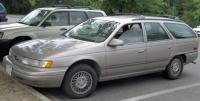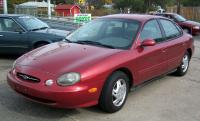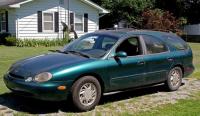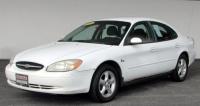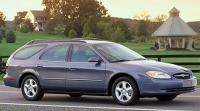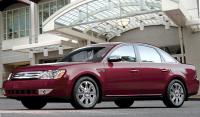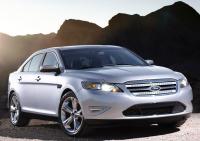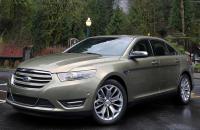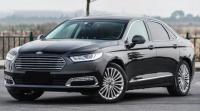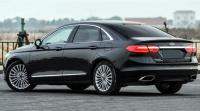The Taurus has greatly influenced the American automobile industry and Ford throughout its history. These are new technologies, and design solutions, and other innovations. In total, more than 7 million units have been produced since 1986, making it the 5th best-selling Ford vehicle in the US.
In the early 2000s, the Taurus was strongly squeezed by Japanese cars on the market, and in 2007 they decided to close production and switch resources to other sedan models - the Ford Five Hundred and Fusion. However, in 2010 they decided to revive the Taurus name, and in 2013 they made a restyling of the last generation. To date, the closest competitors of the car are BMW 5 series, Honda Crosstour, Kia Optima, Infiniti M, Nissan Teana, Mazda 6, Opel Insignia, Peugeot 508, Skoda Superb, Suzuki Kizashi, Subaru Legacy, Toyota Camry and Volkswagen Passat.
First generation
Ford Taurus appeared in 1985 as a model 1986 years and produced until 1991 year, gradually replacing the mid-size Ford LTD. It was the company's second front-wheel drive car. Rounded shapes made this car more economical, which also reflected in the success of this model. Chrysler and General Motors soon began to produce cars with similar shapes, wanting to capitalize on the success of the Taurus.
The first generation was produced with two engines - V6 (3000 cm3 or 3800 cm3) or row four (2500 cm3), as well as with both manual 5-speed and automatic 4-speed transmission. Body in two versions - 4-door sedan or 5-door station wagon.
Taurus developers have made a breakthrough not only in design, but also in the interior of the car. Many of the ideas that first appeared in those years are still relevant and used. A very comfortable interior, an informative dashboard, a lot of adjustments made it possible to customize the car for yourself in order to concentrate on the road as much as possible. For the first time, a very rich variety of equipment and options was offered.
In 1986, about 200 thousand cars were sold, by 1989 sales exceeded the million mark, and in total the first generation sold more than 2 million copies. In general, the car was well received by both Ford fans and critics.
Second generation
The second generation of the car left behind a manual transmission and a four-cylinder in-line engine. Only the automatic transmission and the V6 petrol engine remained. Also updated the design. All body parts have been redone, with the exception of the doors. But in general, the car remained similar to the previous generation.
The interior has been heavily modified. A new, even more convenient dashboard has appeared, the main controls of the car are located to the left of the driver. The radio control buttons were placed on the right to control without taking your eyes off the road. The panel has also been redesigned to accommodate the front passenger airbag. The Taurus is the first car of its kind to feature dual airbags as standard.
During the production of the second generation from 1992 to 1995 about 1.4 million copies were sold in a year.
Third generation
The third generation of Taurus was produced with 1996 to 1999 years. It was a complete redesign of the car. The shape of the car was based on an oval, perhaps inspired by the Ford logo. The car was aimed at wealthier buyers. The exterior has more upscale touches, such as chrome wheels, chrome twin tailpipes, and a stylized badge that says "Taurus", instead of the usual letters in previous generations.
The interior has also been heavily modified to be even more comfortable. The dashboard wraps around the driver a little, with all the main controls placed for easier access and made to be recognizable by touch. Climate control and radio were combined into a common control panel installed in the center of the dashboard. Another novelty was the center console between the two rear seats.
The body types of the Taurus remained the same as before. Engines remained only 3-liter gasoline V6 (Vulcan V6 and Duratec 30), transmission automatic 4-speed.
Despite all the efforts of Ford, this model could not repeat the successes of previous generations. The oval body design is not to everyone's taste. In 1997, Taurus lost the status of a bestseller in the United States, and the palm was intercepted by Camry Toyota companies.
Fourth generation
The fourth generation was produced from 2000 to 2007 year. many elements "oval" design was replaced with rectangular, popular in the second generation. Ford also took the path of reducing the cost of the car for greater competitiveness. So they replaced the rear brakes with drums, removed the dual exhaust system, and also cut a lot of small chips. The Taurus received a more conservative appearance, more like the first two generations, in hopes of increasing the car's appeal.
The interior was also modified to reflect the successes of the first generations, although many of the third generation's features were carried over. The dashboard is straight again instead of curvy, the concept of a common climate control panel and radio has been carried over, but the design has become "square" style and again placed in the center, instead of a slight turn towards the driver. The center console between the rear seats remained, but was also changed.
The body shape, engine and gearbox remained unchanged from the previous generation.
Despite all the measures, sales of the Taurus were falling, as they could not compete with Japanese sedans. Ford decided to stop producing these cars. The last sedan rolled off the assembly line on June 25, 2004, and the station wagon on December 8, 2004. Retail sales stopped in 2006.
Fifth generation
This generation became completely new after the end of production. The new Taurus is based on the Ford Five Hundred, which has been extensively redesigned for 2008 model year. Ford chose to name the Taurus for this model, as it has a long and successful history and reputation among buyers. Over 500 modifications have been made to the Five Hundred model, including a new look, as well as a new Duratec 35 V6 3500 cm3 engine with 263 hp, a new Aisin AW automatic transmission.
Sixth generation
Produced with 2010 years to the present. It was first seen in 2009 at the North American International Auto Show in Detroit. Taurus performed well in test drives and the press was pleased with the new features of the car. Some of them are four-wheel drive, cross-traffic alert, collision warning, blind spot monitoring, adaptive cruise control, push button start, heated front and rear seats, among others.
The design was also liked by many, however, the Taurus is criticized for the lack of interior space and reduced visibility despite the full external dimensions, compared with the closest competitor - Honda Chord.
IN 2013 year, the Sixth Generation Taurus was updated. On the face of cosmetic changes in appearance, new engines, new technologies. The most noticeable external changes are a new front end with clear angles and restyled headlights. The rear has not changed much, but the interior has been left as it was.
Seventh generation
In April 2015, the seventh generation Taurus was introduced at the Shanghai Auto Show. This vehicle is only manufactured and sold in China by Changan Ford, as Ford will only produce SUVs for the US. This full-size sedan is based on a platform «Ford CD4.3», which is also used for Lincoln Continental limousines. Body length Ford Taurus VII is 4996 mm, width 1878 mm, height 1503 mm, wheelbase 2949 mm and curb weight 1707-1875 kg.
The car was equipped only with gasoline engines of the following characteristics: four-cylinder 1.5-liter (1499 cm3, 181 hp) and 2.0 liters (1999 cm3, 245 hp), as well as a six-cylinder V-shaped volume of 2.7 liters (2694 cm3, 329 hp). The transmission is only an automatic six- or eight-speed.
A two-liter engine and an eight-speed automatic appeared in 2019 after the release of a restyling model.
